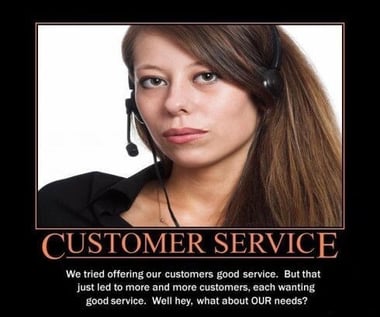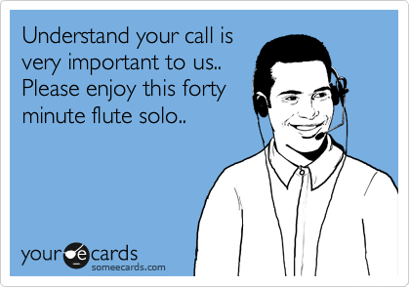Why Bad Customer Service from Big Companies is Hurting Your Business
- More and more large consumer businesses are purposefully devising a difficult and tiresome customer service experience to frustrate customers and generate revenue.
- Many customers simply give up on getting a legitimate refund, replacement, or repair because it's too difficult to get the company to cooperate.
- Although many of these companies can get away with bad customer service, when small to medium businesses treat customers right, good service is likely to stand out even more.
About a 6 minute read.
I finally decided to switch to a new cell phone plan.
It took me a decade or so to finally take the leap.
Call me a creature of habit. Call me a boomer. I’ve been called worse.
I wanted to upgrade from one of those old telecom providers to a newer company with a better plan. While the old provider’s service was okay, it seemed everyone else got much more from their mobile phone provider, yet I was paying much more than they were. What kept me from switching was the fear of having to spend half a day or so enduring the painful process of switching to a new provider. Fortunately, the stars aligned, and I made the switch in less than 90 minutes. In the end, I cut my bill in half. I was ecstatic.
Then came the call to my old provider, to make sure they would stop billing me. For some reason, I didn’t trust them to actually stop billing me, so I decided to err on the side of caution.
I first called their customer service (CS) line and talked to Blessica somewhere in a faraway country where I heard roosters crowing in the background. (I’m not making this up.) Maybe it was her remote location, or maybe she was messing with me, but I spent what seemed like an eternity waiting for her “computer to update” so she could find my record. She was pleasant enough, but after 35 minutes I gave up.
A few minutes later, I spoke to Arwin, another guy with a delightful personality and a strong Tagalog accent. After another 15 minutes of waiting, I became impatient and was a little terse with him, so he transferred me to Anisha. We spent another 25 minutes together, but I was finally able to pay my remaining balance. She promised it was all taken care of, and I should just ignore any future bills, “just in case” they sent one. To be safe, I turned off the automatic billing so they didn’t take my money, and then I would have to fight them to get it back.
It was a good move. Sure enough, a few weeks later, a notice in my inbox said I owed the regular monthly amount, but warned me that my “autopay billing had failed” and now I need to call them ASAP to pay my bill or risk having my service cut off.
It was an empty threat, but I was more concerned about what they would do to my credit, so I called again. This time I spoke to another young man who must have been in training because he was unfortunately and sadly not very helpful, giving all sorts of excuses about why he couldn’t help me. I insisted that I speak to a supervisor, but he replied that none were available. But, he countered, “You could call back any time to see if one was available.”
I hung up and called back.
This time I spoke to LeBron. I don’t think it was THAT LeBron, but he was nice enough. Regardless, we spent another 20 minutes of quality time together, waiting again for his “computer to update,” so he could access my record. (I was seeing a pattern here that computer issues were a common cause for delay.)
I was transferred to Maria in collections, and after five minutes she determined that she wasn’t “set up to access my account,” so she transferred me to the “Wireless” division. I then had the pleasure of speaking with Anna. Some 35 minutes later, we had it figured out. She promised me that I am good to go and won’t receive another bill.
I’m not holding my breath.
After spending 135 minutes trying to solve a very routine issue. I wondered if this was common. As I thought back on several recent experiences I’ve had with customer service, this wasn’t the first time I felt like I was being played.
Maybe I’m just paranoid, but it dawned on me that I have been treated poorly not just by my cell phone provider, but also by my cable company as well as the online travel site where I booked a flight and a hotel. I realized how much I hated to call customer service, especially when I was dealing with a monolithic, market-dominating company, like my old cell phone provider.
Why do they make it so difficult to conduct business with them?
I’m not just talking about the typical frustration in dealing with an automated phone tree, pushing “zero” to get an operator, or having to shout “customer service” a few times until the computer finally understands you.
I’m talking about having more frequent customer service experiences that are over-the-top annoying, time-consuming, and generally a PIA (see definition). Especially when I was trying to get them to do their job, to cough up money they owed me, or to fix something they were obligated to fix.
 I thought we were living in the era of CS? That we were more enlightened about the importance of treating customers right? That “surprise and delight” was the new mantra if you wanted to grow your market share.
I thought we were living in the era of CS? That we were more enlightened about the importance of treating customers right? That “surprise and delight” was the new mantra if you wanted to grow your market share.
Am I so naïve to believe that profitable companies would never want to use poor CS as a means of generating income?
The answer is yes. I AM that naïve.
I learned how truly uninformed I was when I stumbled upon a bunch of articles highlighting the practice of using CS as a sort of weapon. But my mind was blown after reading this article in the Harvard Business Review called “Why Is Customer Service So Bad? Because It’s Profitable. They highlighted a 2017 study by Arizona State University revealing that many companies, especially bigger companies in technology, finance, and travel, are set up to make it difficult for customers who call in, using a complex hierarchical call center structure.
It works like this: they don’t allow the initial call center rep, the “Level 1” agent, from offering any type of refund. These reps are authorized only to give the status of an existing order, and on some rare occasions, send a replacement. That’s it. Only the “Level 2” agents, the “supervisors,” were authorized to give a limited refund, but a “Level 3” agent was given the most flexibility to offer refunds. It’s all a deliberate strategy to “reduce the amount of redress costs" given back to customers.
What these companies realized was if they force customers to wait on hold, jump through hoops, and wade through their bureaucratic organizational structure, a statistically significant percentage of these charlatans will get frustrated and just go away.
The bottom line is that treating customers poorly is actually boosting their bottom line.
Overall, the study found that many companies deliver a poor customer experience not out of neglect, but as part of a deliberate strategy. It’s a scheme to put roadblocks in the way of customers seeking a refund and to make customers so annoyed that they’re willing to leave money on the table. The result is these companies end up paying “lower average payouts and refunds,” than if they offered efficient, customer-friendly service.
 Am I reading this right? Companies are profiting from intentionally giving bad customer service?
Am I reading this right? Companies are profiting from intentionally giving bad customer service?
The answer is YES! And it’s happening with more frequency and with greater precision than I’d ever thought possible, especially in today’s consumer-driven environment where online reviews are so important.
How it all started
Illegitimate or fraudulent refund claims have been a huge drain on companies for decades. Reducing those fake claims, (especially when you’re talking about big-ticket items like computers and other electronics) makes good business sense. Once they found a way to force these hucksters to endure a complex and painful verification process, a significant number of these swindlers simply gave up and went away.
That seems like a positive solution to a very difficult and expensive problem, but after a time, many of these companies discovered a hidden benefit that went beyond reducing fraudulent claims. They learned that this built-in friction also reduced the total amount they had to spend on refunds, repairs, and the costs of replacing defective parts, or what the study calls “redress costs.” It also means that everyone gets treated like fraudsters, even your otherwise loyal, dedicated, and honest customers. And they're okay with that.
"It also meant that otherwise loyal, dedicated, and honest customers get treated like fraudsters."
As it turns out, these companies have determined that customers are expendable. If one of their customers is angry and frustrated with your company, oh well…that’s just the cost of doing business.
Isn’t that a recipe for losing market share? Isn’t there a consequence for putting short-term profits ahead of long-term growth?
Unfortunately, it doesn’t seem to be a big concern.
When Bad Customer Service Pays Off
Although the study found that roughly three-quarters of customers were unsatisfied with their customer service interaction, there’s no clear evidence that companies were necessarily suffering because of it. At least not for certain types of companies that dominate a market.
Take for example the 2017 incident where a paying passenger was violently removed from a United Airlines flight. United didn’t publicly apologize to the passenger. They also bungled the aftermath, showing a complete lack of empathy for the bloodied passenger. The CEO insisted they were simply “re-accommodating” the passenger because the flight was overbooked, and it’s how all airlines work. When the social media backlash and bad press mounted, most pundits predicted UAL’s market share would shrink, and their stock would tank, but that didn’t happen. In fact, two months after the incident, UAL’s stock had climbed 15 percent. They not only kept their market share but didn’t seem to suffer much as a result.
Stock analysts pointed to the lack of competition as a reason why UAL didn’t suffer from the incident, saying: “With passengers having fewer options (in these markets) … UAL's revenues may not suffer as much as expected unless passengers opt for longer and more expensive flights.”
So how does bad customer service at these big companies impact your business?
Poisoning the Well
This study found that 42% of consumers would rather clean a toilet, than call customer support.

So because consumers are increasingly encountering horrible customer service, you can’t blame them for assuming your organization will likewise treat them like doggie doo.
Unfortunately, when these big companies purposefully mistreat their customers, it poisons the well for the rest of us who are truly committed to delivering outstanding customer service.
Yet because so many of your members/customers have experienced horrible customer service, who can blame them for assuming your organization will likewise find a way to make their life miserable?
The sad fact is, before your team ever takes a call, many of your customers are already in battle mode, assuming you’re going to be painfully polite yet unhelpful, just like their last CS encounter with a big company.
Unless your CS team is trained and focused, it's not likely to end well. But if your organization is prepared and truly eager to help, you'll have a surprise and delight moment than can differentiate your company and help you grow your business.
How do you win customers over and convince them you’re truly interested in helping them solve their problems?
8 Ways Customer Service Can Exceed Customer Expectations
After researching this issue, I’ve leaned heavily on customer service expert Shep Hyken to create my curated list of eight ways to make sure your customer service experience is truly world-class:
- Train, train again and then train some more. Train your reps to be extra patient with disgruntled customers. While some people are naturally nasty, most are not usually that way, but they assume they have to be aggressive just to get what they need. Train your reps to listen to customers with real empathy, especially when callers are rude and disrespectful. Train your CS team to identify the emotions customers are displaying and teach your team to acknowledge those feelings. Customers will be more receptive to your solutions if they are convinced you to understand their issues AND their emotions. Train CS reps to find solutions, using phrases like “Let me see what I can do,” or “Here’s what I can do,” instead of “I can’t do that,” or “I’m not authorized to…”
- Be extra nice to your customer service reps. Being on the front lines can take its toll on your people. Don’t just tell them to “suck it up” or “deal with it.” They take a lot of unnecessary verbal abuse from customers, so don’t add to that abuse by treating them like second-class employees. CS expert Shep Hyken suggests “Treat your (CS) staff as well as you want them to treat your customers–maybe better.”
- Empower Level 1 customer service reps to be true problem solvers. You’d be amazed at the incredible problem solving-skills of your trained and qualified CS reps. They can diffuse explosive situations better than McGyver if given the chance. Give them the authority to resolve issues, even if it means giving refunds. And don’t punish them if they admit your company is at fault. Nothing can drive up your churn rate among your CS reps, than a real (or perceived) lack of trust and empowerment to do their job. If you ask CS reps what they like most about their job, it’s being able to truly help people be happy. Empower your CS reps to have more of those helpful experiences.
- Keep finding ways to reduce friction: Most good call centers monitor important metrics like service level (the percentage of calls answered within a certain timeframe), or FCR (first call to resolution) rate. These are important, but these metrics are helpful in measuring your CS rep’s performance. What your CS reps can’t change are things like how much your company leans on your IVR system. It’s up to management to figure out how to reduce friction, like the number of times customers are forced to jump through hoops just to get one of your CS reps on the phone. One of my pet peeves is having to listen to the disingenuous announcement that by some random chance I’ve been “selected to complete a survey.” I would love it if they skipped the automated invitation and instead allowed the CS rep to ask me to complete the survey. I’d be more likely to do it if I was asked by another human. And while I’m at it, I’m also annoyed when I’m forced to provide my personal info to an IVR system (that usually doesn’t listen very well), only to have the CS rep ask for the exact same information. Is that really necessary?
- Deliver live, multi-channel customer support. Give your customers more than just one way to communicate with you, such as web chat, email, social media, as well as voice. There’s nothing more annoying to me than not having the option to speak to a human being about a complex problem. Instead, I’m forced to wade through their “self-directed customer service” FAQ, or if that doesn’t work, use a web form. I can’t tell you how many times I’ve had to use a web form to submit my problem to customer support, and after writing a thousand-word novelette, the form glitches out and forces me to start all over again. Don’t be that company. A live person, even if it’s via chat or social media, is always better than automation or self-directed customer support.
- Avoid transferring customers to multiple agents. If your organizational structure is so siloed that only certain people can resolve certain issues, re-think your process. Assess your methods and call flow to find ways to improve efficiency. Identify any trends in your customer feedback, and don’t let your company’s quirky organizational structure drive a poor customer experience.
- Limit hold time. No matter how beguiling your hold music may be, it will never enthuse your customers. In fact, you may be making them angry the longer they have to listen to it. If you don’t have the technology to tell the caller an approximated wait time, get it. Setting proper expectations can go a long way toward keeping your customers happy.
- Go the extra mile. Maybe I’m a bit biased, but I love how our own CS team at Access will do whatever it takes to make our users happy. For example, we process thousands of hotel bookings each month, and our team has carved out time to contact each hotel booking to reconfirm every reservation made by our members. By doing so, we can identify problems and fix them well before our member shows up at the check-in desk. We’ve saved a ton of potential mishaps and customers remember that elevated level of service because it's so unique.
According to the Achieving Customer Amazement study, 90% of customers report they are willing to abandon a brand after having a bad customer service experience. While that seems a bit high, if the reality is even half that number it still underscores the importance of going above and beyond to treat your customers right.
Another study showed that 74% of consumers said they are more loyal to a business that provides them with the option to speak to a human, than those that only support customer service through digital or self-service channels. Consider these studies to be an opportunity for growth and differentiation.
As consumers begin to figure out that some companies are purposefully mistreating them, you can expect some of your customers to assume you’re going to do the same thing to them. For us small and medium-sized businesses, we are often the unfortunate casualties when even a few big companies choose to mistreat their customers. Consequently, we must double down on our commitment to “surprise and delight.”
Unlike some of the big corporate brands, most of us can’t take any of our customers for granted. We’ve invested too much time and resources into acquiring and retaining our existing customers.
I may be old-fashioned, but I truly believe brand equity is too hard to earn, only to be squandered away on a single phone call. No matter how big you are, it’s foolish to put our hard-earned brand equity at risk for a relatively small amount of short-term revenue.
What are your thoughts? Have you noticed a rise in bad customer service among certain types of businesses? Does your company provide a memorable customer service experience, or do you have room for improvement? I’d love to hear your views. Start or join the conversation below.
Topics: Customer Engagement, Member Benefits, customer service, customer retention, Customer Services
Written by: Gary Toyn




.jpeg)







Share your Comment.